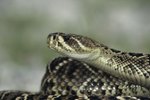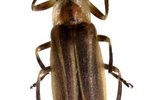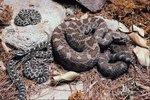
As much as many people would love the splendor of sleeping away the winter, it's not a realistic dream. Some animals, however, have the luxury of skipping the harshest weather by sleeping it away in cozy dens or other homes. During hibernation, the heart and breathing rates drop tremendously, as well as the body temperature. Many reptiles, mammals, insects, amphibians and even one bird practice some form of hibernation during the winter.
Reptiles and Amphibians
Snakes hibernate during the cold of winter because they're cold-blooded animals. Surprisingly, even normally solitary snakes will create a hibernating mass; a den of over 8,000 garter snakes was once discovered in Canada, although dozens of garter snakes is more likely. Some snakes hibernate in dens with other species; the black rat snake, for example, often dens with timber rattlesnakes and copperheads. The garter snake is the last snake to go into hibernation and the first to emerge in the spring. Other species wait for warmer weather. Box turtles, on the other hand, reduce their heart rate to one beat every five to 10 minutes and they stop breathing.
Bees
Most bees, wasps and their kin hibernate in one way or another. Many species have only one survivor per colony every year: the queen. When the males and workers die off in the fall, the queen finds a safe, warm place to hide until the following spring. Small, protected holes in the ground or under leaf litter are two prime examples of hibernation spots fit for a queen. In many cases, the hibernation lasts for most of the year -- six to eight months. Carpenter bees hibernate in the tunnels created by their mother and then emerge in spring to mate and start their own tunnels.
Mammals
Several mammals hibernate during the long, cold winters. Woodchucks are one example of true hibernators. During their hibernation, the woodchuck's heart goes from 80 beats per minute to only four or five. It also drops its body temperature to 60 degrees below normal. Chipmunks and bats are other examples of true hibernators. Bats huddle together in a protected place -- such as a cave -- that stays above freezing. Hedgehogs have been known to stay asleep during the whole winter, something that even other true hibernators can't accomplish.
Light Hibernation
Many of the mammals that are considered "light" hibernators still pack on the pounds and fat like their deep-sleeping comrades. The difference is that light sleepers take long naps rather than going into a slumber so deep they cannot be awaken. Bears, raccoons and skunks all take long naps as opposed to going into a true hibernation. While true hibernators will sometimes wake up to forage for food, light hibernators get up more frequently. Their long naps may be several days, weeks or months long, but their bodies don't go through changes as extreme or long-lasting as the true hibernators. Like true hibernators, these species lower their body temperature, heart rate and breathing rate during the winter while they're sleeping. An example of waking up for other duties and activities is bears: many give birth to and care for their young during their hibernation period.
References
Resources
Photo Credits
-
Jupiterimages/Photos.com/Getty Images
Writer Bio
With a professional background in gardening, landscapes, pests and natural ecosystems, Jasey Kelly has been sharing her knowledge through writing since 2009 and has served as an expert writer in these fields. Kelly's background also includes childcare, and animal rescue and care.




